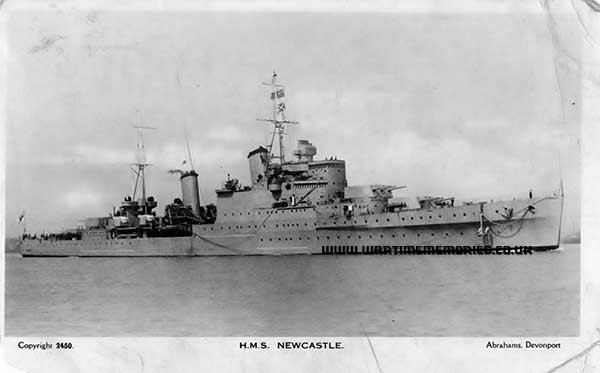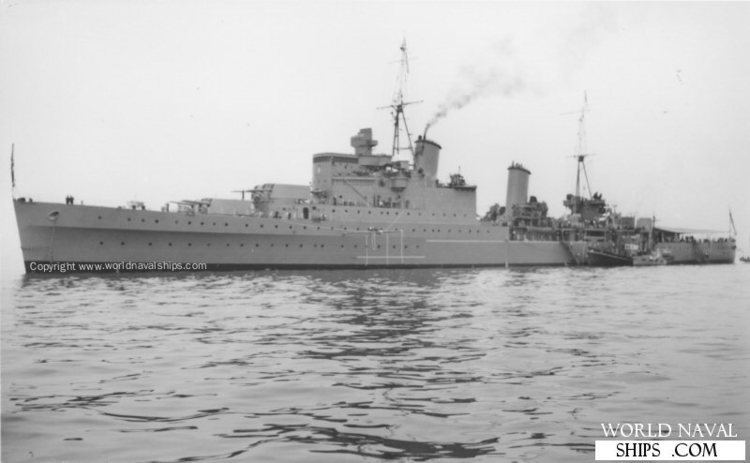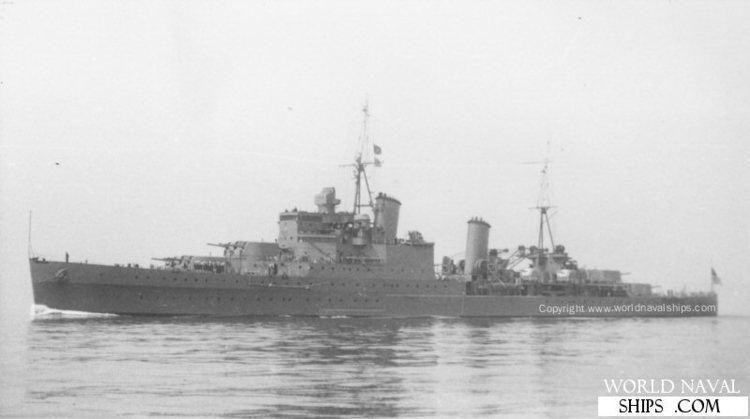Name HMS Newcastle Commissioned 5 March 1937 Identification pennant number C76 Launched 23 January 1936 Draft 6.55 m | Laid down 4 October 1934 Decommissioned 1958 Construction started 4 October 1934 Length 170 m Builder Vickers-Armstrongs | |
 | ||
Fate Sold for scrap in August 1959 | ||
The seventh HMS Newcastle was a Town-class light cruiser of the Royal Navy. She belonged to the Southampton subclass. In the Second World War following extensive battle damage sustained in the Mediterranean, she spent some time being repaired in New York. She also saw action in the Korean War.
Contents

Interwar period

Newcastle was laid down by Vickers Armstrong on 4 October 1934, launched on 23 January 1936 by Her Grace the Duchess of Northumberland and commissioned in March 1937. She joined the 2nd Cruiser Squadron, and was under refit on the outbreak of war. After the refit was completed, the ship joined the 18th Cruiser Squadron with the Home Fleet in mid-September 1939, initially being employed on trade protection duties in the Western Approaches, she then joined the Northern Patrol.
Second World War

During the initial part of the Second World War, Newcastle engaged and badly damaged two German destroyers off Brest. She also set a record during this period by staying at sea continuously for 126 days.

On 23 November 1939, Newcastle encountered the German small battleships (or battlecruisers) Scharnhorst and Gneisenau but they escaped in bad weather before other ships could come up.

Newcastle was involved in an abortive action under Vice-Admiral James Somerville on 27 November 1940 against the Italians at Cape Spartivento. After operating against blockade runners in the South Atlantic, the ship was sent to the East and then redeployed to the Mediterranean as part of Operation Vigorous, (convoy escort) from Alexandria to Malta in June 1942.

Four days out (of Alexandria), Newcastle was torpedoed by the German E-boat S-56, on 15 June, blowing a complete hole through her bows. The crew saved the ship, which returned at 4 knots (7.4 km/h; 4.6 mph) to Alexandria, where she could not be fully repaired but was offered facilities to make her own temporary repairs. This meant building an additional wooden bulkhead, strengthened by concrete, behind the damage. This bulkhead had to be replaced at ports in India, Ceylon, South Africa and Brazil, before she finally arrived in October at Brooklyn Navy Yard, New York, where new bows were built by March 1943.
From New York she sailed to Plymouth and then on to join the Eastern Fleet at Ceylon (now Sri Lanka), and acting as the lead ship of the 4th Cruiser Squadron. During her time with the Eastern Fleet, Newcastle participated in the bombardment of numerous Japanese-held islands and supported the British Fourteenth Army in their campaigns in Burma.
Postwar

After the war, the cruiser was given an extensive modernisation in 1951-2, with a new bridge, New Mk 5 40 twin 40mm light AA armament and Type 275 radar to control its twin 4 inch guns and took part in the Korean War - acting as a flagship and providing naval gunfire support to UN forces - and the Malayan Emergency in the later 1950s.
Decommissioning and disposal
Newcastle was decommissioned and sold for scrap in 1959, and subsequently broken up at Faslane.
